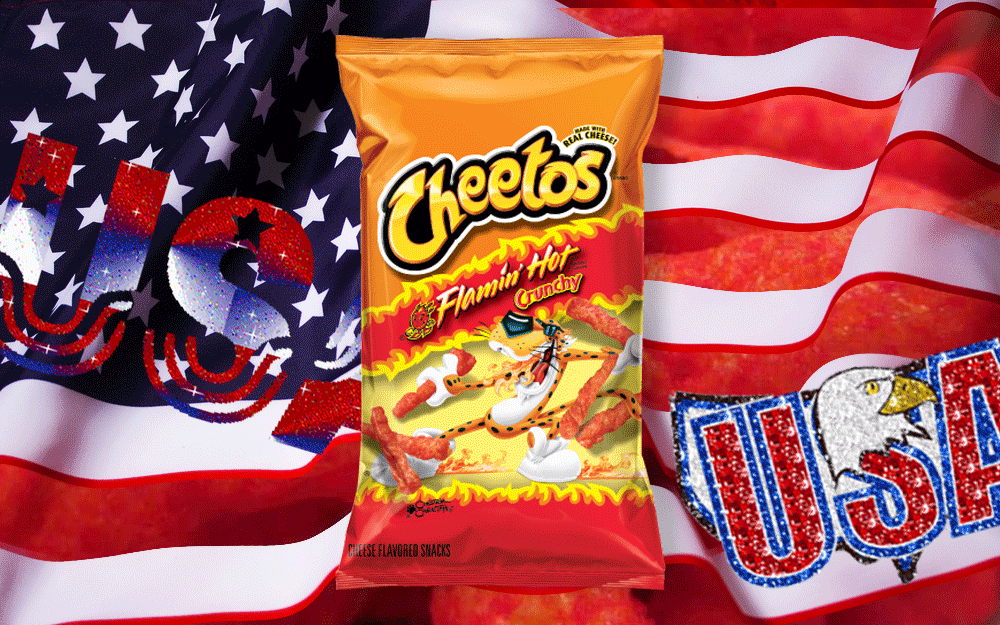The most inspiring biopic to come out of Hollywood in the next few years won’t be about a politician or war hero. It won’t follow the life of a tortured artist or scientist. It definitely won’t be the Scorsese film where Jamie Foxx plays Mike Tyson. No, the flick that’s destined to nail us in the feels with a true-to-life story is Flamin’ Hot, a Fox Searchlight project based on the American dream of one Richard Montañez, the genius who blessed the world with Flamin’ Hot Cheetos — a snack we could no longer go without.

Montañez, if you didn’t know, immigrated to California from Mexico as a child and grew up helping to support his family by picking grapes. He dropped out of high school in the mid-1970s and took a job as janitor in the Frito-Lay factory in Rancho Cucamonga. As legend has it, an assembly line glitch one day produced Cheetos without their distinctive orange dust, so Montañez took some home to coat with chili powder, à la elote, or Mexican street corn. The experiment was so successful that he bought a $3 tie and presented his new recipe to executives.
Flamin’ Hot Cheetos hit shelves in 1991 and became one of Frito-Lay’s most successful products, surging in popularity year after year as more varietals debuted. Montañez is now himself a vice president of branding and sales at Frito-Lay’s parent company, PepsiCo, leading the Hispanic advertising team and renowned as the “Godfather of Multicultural Marketing.” He supports the Latino community through everything from charity donations to college scholarships.
Montañez’s brilliant insight — that to limit your snack flavors to salty and BBQ offerings is to overlook a vast demographic that values spiciness — wasn’t just a measure of his business acumen. It’s also a beautiful statement on the blending of cultures.
America has always been deeply indebted to her immigrants, but it’s the country’s continued openness to their ideas and influence that allows for a triumph like Flamin’ Hot Cheetos, which have claimed acolytes and addicts from every walk of life (and precipitated health-conscious crackdowns in schools from Illinois to California).
On that last point, Flamin’ Hot Cheetos dominate digital consciousness as the premier junk food of the younger, increasingly diverse generations, singular and iconic in seasoning, appearance, form and function.
@Fritolay @PepsiCo did you see @katyperry this Halloween? Brilliant! #flaminhot #cheetos #godfather @RPMontanez pic.twitter.com/Ex1HAN4OCa
— AdelantePAC (@AdelantePAC) November 3, 2014
Flattered that @katyperry enjoys my creation so much! Loved her costume. Here I am jammin' to her creation. #Cheetos pic.twitter.com/vwJXoyo4Bf
— Richard P. Montañez (@RPMontanez) November 5, 2014
For any artifact to become a meme, it needs a kernel of relatability. Memes spread because many of us share a peculiar emotion or circumstance — the element of a joke that makes us say, “That’s so me.” Everything that comes along with Flamin’ Hot Cheetos, it would seem, catches at that social bond. They’re an equal obsession for celebrities and commoners. We all know the stickiness of that atomic-red coating and the uncanny way in which it manages to taste only like itself, an item without a culinary analogue or imitator. They’re generously shared or jealously guarded among friends, the guilty pleasure that resists adulthood and celebrates indulgence as a fundamental right. Flamin’ Hot Cheetos can garnish your Bloody Mary or grace your leggings and hoodies. They can even serve as the special ingredient in your stunt Thanksgiving dish.
https://www.instagram.com/p/BVEO40VFxLz/
https://www.instagram.com/p/BYvyHrTA_GD/
Bags of Flamin’ Hot Cheetos are haute couture accessories as well as a crucial plot device in Orange Is the New Black. In the time it’s taken me to write this piece, eBay appears to have deleted a listing for a Flamin’ Hot Cheeto shaped like the Eiffel Tower, with an asking price of $50. You’re in luck, though — this dick-shaped alternative could be yours for as little as $1. (On the other hand, if you’d like to invest a substantial amount in a collectible Flamin’ Hot Cheeto, you might consider this $18.99 guy with a passing resemblance to Snoopy from Peanuts.) Flamin’ Hot Cheetos are also a hairstyle, a hustle, a party and an immersive experience. They are both a seductive bedroom-pop song and a rap video with 16 million views.
What else in the pantheon of corn-based vending machine fare has this kind of saturation or impact? If you woke up tomorrow to a world from which Flamin’ Hot Cheetos had vanished, would you actually recognize it as reality? Are they all that keeps us from rejecting 2018 as a fucked-up simulation?
If Oscar Isaac doesn’t play Richard Montanez in this movie then what is the point of anything? https://t.co/WLC4kcmLlP pic.twitter.com/7Cc88QpItH
— cherie saulter (@cherielovesyou) February 22, 2018

No, Flamin’ Hot Cheetos aren’t part of a nutritious diet. They stain absolutely everything, and there’s a masochism built into their appeal — “HEADBUTT YOUR MOUTH’S FACE,” one notable billboard advised — that makes them perhaps the perfect cheap delicacy for YouTube’s “challenge”-oriented aesthetic. I bought them myself to munch on this afternoon, and the last few fistfuls I inhaled have my scalp and forehead atingle with sweat.
But when it comes to chips and similar treats, pure compulsion drives the brand: “Bet you can’t eat just one,” “Once you pop, the fun don’t stop,” etc. Yet Flamin’ Hot Cheetos require us to pause every now and again to savor the exquisite pain of wolfing down the 3.5 servings in a 3.5-ounce bag. You can’t help yourself, but you can confront the paradox that is dependence on a mass-produced edible novelty your grandparents probably wouldn’t consider food. They foster a strange self-awareness.
https://twitter.com/sabiiiiiii/status/970710049365614593
So Montañez’s achievement, beyond a borderless fusion of Mexican and American gastronomy, is spiritual in nature. Flamin’ Hot Cheetos have a personality, and it’s woven into the hearts and minds of those who love them, who love to get ill from eating too many, who treat each knobbly neon stalk as an individual blessing. To enjoy Flamin’ Hot Cheetos is to feel seen and appreciated by a late capitalist system otherwise indifferent to our desires. Best of all, Flamin’ Hot Cheetos prove that there’s no such thing as a niche delight — only joys that haven’t been discovered yet.
Now let’s make sure that theaters start selling them before Montañez’s story appears on screens.

